At The Leather Doctor, we have over 30 years of experience in leather cleaning, leather repairs and leather restoration. Suffice to say, we’ve seen it all!
As a professional leather repair network, we’re often the first port of call for customers who need help or guidance with leather repair services.
With all that we’ve seen and experienced in leather repairs and restoration, we’ve pulled together a guide to the most common leather problems our customers experience. From there, we’ve given information on prevention of the issue and highlight the leather repair services available to resolve each issue.
Common Issues with Leather Furniture:
Before diving into some of the most common leather issues, it’s important to note that leather has many redeeming qualities!
There are several reasons why leather is enjoyed by so many across furniture, car, boat and commercial finishes –
Quality
Leather is associated with top-of-the-line furniture products. The look, feel, and smell of authentic leather exudes class and luxury.
Durability
Leather is tough but flexible allowing it to last well, providing it’s well looked after.
Comfort
Leather provides superior comfort as it’s soft to the touch and naturally adjusts to body temperature. In fact, as leather wears and gets broken in with regular use, it often becomes more inviting.
Appearance
Authentic leather gives off a rich and luxurious appearance. Each piece of leather is unique with its own natural markings, grains, and blemishes.
Hypoallergenic
Leather is a great choice for those who suffer from allergies as leather doesn’t harbour dust mites, pet hair or allergens as easily as fabric furniture does.
Cleanable & Repairable
Finally, and most importantly, leather is easily cleanable and repairable with the assistance of leather repair services.
However, just like other high-end products, it’s important to highlight that just because leather is expensive, it does not mean it’s bulletproof.
First and foremost, the longevity of leather comes down to the care that it receives.
Read on to learn about some of the most commonly encountered problems with leather furniture, as well as tips on prevention and treatment by our professional leather repair network.
Issue 1 – Body Oil Damage
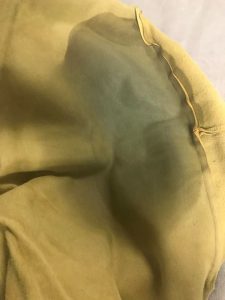
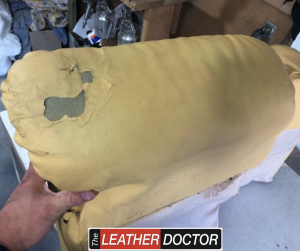
A common problem to arise with leather furniture is damage caused by body oil.
Body oil and sweat damage is often most predominant on the skin touchpoints of furniture, such as the headrest, armrests or leg roll.
Leather absorbs body oils and perspiration from skin and hair. Over time this accumulation of oil can darken and discolour leather upholstery. This can eventually lead to cracking and/or peeling of the leather.
As living and breathing humans (as well as our living and breathing pets), it’s normal to produce natural body oils and sweat. As such, there is not much we can do to avoid exposing our leather furniture to body oil damage.
Nevertheless, tending to our leather furniture is much like tending to our skin. After a long sweaty workout, we wash our skin in the shower using soap and water to prevent a rash or skin blemishes. Similarly, regular cleaning of your leather furniture by a leather furniture restoration specialist can prevent the negative effects of leather furniture’s exposure to body oil.
When leather starts to dry out due to lack of moisture (typically due to not being properly cleaned and conditioned), it will essentially want to be fed (akin to dry skin needing moisturiser). At this point, it will begin to take the moisture from you in the form of body oil. Whilst body oil damage may not be apparent at first, it will continue to build up over time, leading to possible extensive damage to your leather furnishings.
Prevention
We suggest regular professional cleaning of your leather furniture to remove any build-up of oils, sweat or dirt and then a thorough professional conditioning to help add moisture into the leather and protect it from absorbing any unwanted nasties.
Treatment/Repair
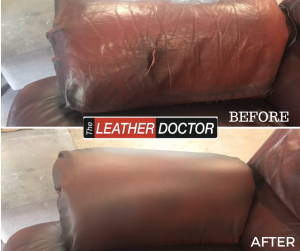
Oil damage due to improper cleaning techniques or negligence is an issue that we come across almost daily during our leather repair services.
Once body oil has contaminated leather, it is very difficult to reverse or repair. Whilst customers often ask for a leather repair involving the re-application of colour, it is often not a viable fix. Unfortunately, the dye may not permanently solve the discolouration problem because the body oil prevents the proper bonding of the new dye. Imagine trying to stick a band-aid onto an oily arm. It may stick for an hour or so, but eventually, it will slide right off.
The Leather Doctor offer leather repair services to treat oil damaged panel of leather furnishings. To discuss your leather repair requirements, or for a free quote, contact your local Leather Doctor today!
Issue 2 – Colour Fading
Another common issue our customers have with their leather is fading. When you first purchase a piece of leather furniture, the pigment of the leather is deep and rich-looking. Unfortunately, like all fabrics, leather can fade over time when exposed to ultraviolet light or heat.
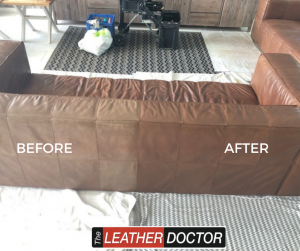
The most common source of leather fading is exposure to direct sunlight. Close proximity to a fireplace and/or furnace can also cause fading and colour change in leather upholstery.
If your leather furniture is exposed to too much sunlight it may be at risk of drying out, fading, or, both. Fading is generally seen in aniline and semi-aniline leather, it’s very rare to see fading in top quality leather finishes that come with a semi-protective cover.
Drying however is something the sun will do to any kind of leather, regardless of whether it has a protective covering or not. Sunlight slowly evaporates the moisture that is present in the leather’s natural oils, this will lead to stiffening and cracking of the material.
Prevention
There are a few ways you can prevent (or reduce) sun damage or fading occurring to your leather furnishings.
Prevention from Drying
- One of the best ways to prevent the drying of your leather lounge is to have it professionally cleaned and conditioned every 6 months. Cleaning and conditioning with high quality, fit for purpose products by a leather restoration expertis directly correlated to how long your leather lounge will last.
- It’s also advised that you keep your leather furniture out of direct sunlight. Dark colours tend to absorb more sunlight and heat, so if you’re placing leather furniture in a room that gets a lot of sun, consider choosing a lighter shade or colour of leather.
Prevention from Fading
- As much as possible, try to keep your leather lounge out of direct sunlight, or close the blinds in rooms where floods of sunlight hit furniture during the hottest parts of the day.
Treatment/Repair
We offer leather restoration to treat leather colour fading and discolouration via our leather repair services. Once fading has occurred, leather restoration can be achieved via our specialised leather recolouring services. The cost to recolour leather will vary depending on the size and extent of the damaged area.
To discuss your leather restoration requirements, or for a free quote, contact your local Leather Doctor today!
Issue 3 – Cracking
Cracking is another problem that our leather and vinyl restoration specialists frequently encounter. Cracking on leather and vinyl furnishings often points to issues relating to a excessive drying or/and a lack of moisture due to infrequent conditioning.
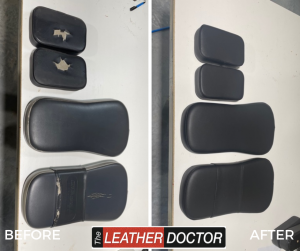
Although all leather is susceptible to cracking (if left long enough without being conditioned), it is more common in combination leathers – specifically vinyl. Vinyl is commonly used to cover medical related furnishings such as chiro/massage beds and dental chairs as well as gym equipment and restaurant/café seating
Much like skin, vinyl adapts to its environment. Just like our hands and lips get dry and crack as we adjust to seasons and weather fluctuations, vinyl does the same.
The contrast of harsh winter air and hot summers can eventually dry out leather and vinyl upholstery and lead to cracking if it is not maintained. The exposure and build-up of body oil and sweat (as described in point 1) and a lack of professional cleaning and conditioning on vinyl surfaces are also key contributors to cracking occurring.
Prevention
To avoid drying and cracking of your leather and vinyl furnishings, it is recommended that you –
- Keep them away from direct sunlight or harsh heat sources that zap moisture
- Regularly clean all vinyl and leather furnishings with high quality cleaning products to remove any build-up of body oils and dirt
- Regularly condition all vinyl and leather furnishings to reinstate vital moisture back into the material and help prevent subsequent cracking
Treatment/Repair
When it comes to repairing damaged leather, our leather repair network can walk you through customised solutions. Whilst in some cases, leather repairs may be viable, in others, where the upholstery has suffered from extensive cracking or exposure to body oils and sweat, upholstery may be the recommended solution.
To discuss your leather repair or upholstery requirements, or for a free quote, contact your local Leather Doctor today!
Issue 4 – Peeling
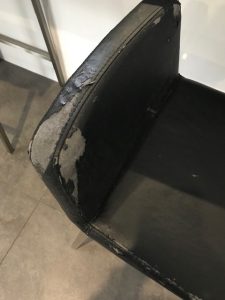
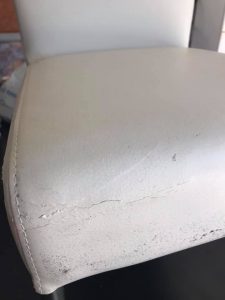 Customers often contact us to undertake leather repair services on their peeling leather. Peeling as an issue is is more common in highly processed leather such as faux, PU and combination leathers. The heavy coating on these man-made leathers, more easily delaminate and result in ‘peeling’.
Customers often contact us to undertake leather repair services on their peeling leather. Peeling as an issue is is more common in highly processed leather such as faux, PU and combination leathers. The heavy coating on these man-made leathers, more easily delaminate and result in ‘peeling’.
Peeling can occur due to one of two things, either external influences or internal influences.
As previously mentioned, peeling can occur once the leather has been damaged by body oil and/or cracking. Once the leather has either worn down or cracked, friction on these areas will cause the upholstery to lift up and peel off.
Alternatively, leather can also experience peeling as a result of improper processing.
Prevention
Whilst some cases of peeling are a direct consequence of the material used (and therefore cannot be entirely prevented), actions can be taken to help protect against peeling, in the same way that body oil damage and cracking can be managed. By regularly cleaning your leather upholstery and keeping it away from windows and/or heat sources, you can help it live longer. Regular conditioning of your leather is also vital for long-term viability.
Treatment/Repair
Much like a nasty sunburn, once leather begins peeling, there is no real end to it. Unfortunately, there is no way to repair a bad case of peeling leather. Instead, we recommend you speak with one of our leather repair experts about reupholstery.
To discuss your leather repair requirements, or for a free quote, contact your local Leather Doctor today!
Issue 5 – Loosening
The final issue our leather repair specialists are often contacted about is the loosening or puddling of leather. When you first purchase leather furniture, the leather is generally tightly pulled and nicely hugs the seat cushions. But as a natural material, leather has some give to it, meaning that the leather can slowly soften with regular use.
As such, some customers experience their leather upholstery loosening over time. While the leather slowly loosens, the foam in the seat cushions also softens and can lose its original shape. A combination of the leather loosening and the foam losing its shape can result in what we refer to as “puddling”. Puddling is when the top of the seat doesn’t appear as tight and pulled as it did when purchased. In addition to puddling, the loosening of leather can result in wrinkles in your leather upholstery.
Prevention
Unfortunately, you cannot 100% prevent the loosening of leather over time. If anything, puddling and wrinkles are a good indicator that you’re getting good use out of your furniture. With this being said, the more solid the foundation encased by the leather, the less stretching may occur. There is a chance that a denser seat cushion could prevent or slow down the eventual effects of leather loosening.
Treatment/Repair
If you’re experiencing puddling in the seat, you may consider re-stuffing or replacing the foam. With the cushion returning to its original shape, the leather may tighten up. Otherwise, reupholstery is a viable option if you wish to eliminate all signs of loosening and restore the tightness of the leather on furniture.
To discuss your leather repair or upholstery requirements, or for a free quote, contact your local Leather Doctor today!
How to Prevent The Most Common Issues with Leather Furniture
Leather is comparable to human skin, and so is the way to care for it!
Just like skin, many problems that arise with leather furniture, such as oil accumulation, dryness, or cracking, can be prevented with proper care.
- Regular leather care can help avoid common leather problems, but it cannot guarantee that they will not occur.
- The importance of professional cleaning and conditioning, with high quality fit for purpose products should not be underestimated. Our leather restoration experts are available to assist with both leather cleaning and conditioning to furnishings in private and commercial settings.
- Avoid exposing your leather furniture to excessive amounts of dirt, grease and body oil.Avoid sleeping on your leather furniture regularly or sitting down if you come in sweaty and dirty from outside. It’s a good idea to try to cover any leather seating that see a lot of dirt and oil if possible. Try tossing a blanket over the headrest of a leather recliner you know you are going to rest your head on frequently or for extended periods of time.
In Summary…
So there you have it – a summary of some of the most common ‘issues’ regarding leather that we receive. Just like anything, proper and consistent care will see your leather furnishings look and feel better, for longer. Consistent professional cleaning and conditioning will go a long way in preventing many leather repair issues from being encountered.
The Leather Doctor lead the way in vinyl and leather repairs in Australia. We help leather and vinyl live longer and provide cost effective solutions to prevent having to replace your lounge. Being specialists in leather and vinyl damage enables us to provide expert advice and cost-effective repair solutions that ensure you can use your leather furniture for years to come.
Using a Leather Doctor to attend to your leather repairs ensures you’re getting the best in the business. Our premium leather repair service helps transform damage caused to your leather furniture, leaving it looking like new and able to be used for many years to com.
To discuss your leather repair requirements and for a free quote, contact your local Leather Doctor today!



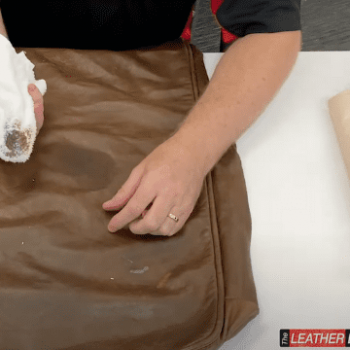
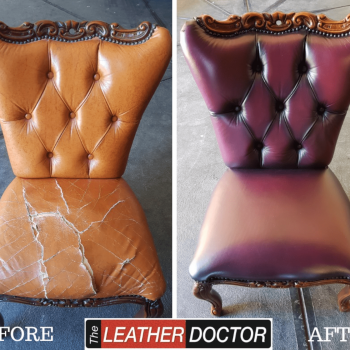

1 Comment. Leave new
Would oil from your head stain and peal the leather within the first eighteenth months of receiving your lounge it has been cleaned only three times